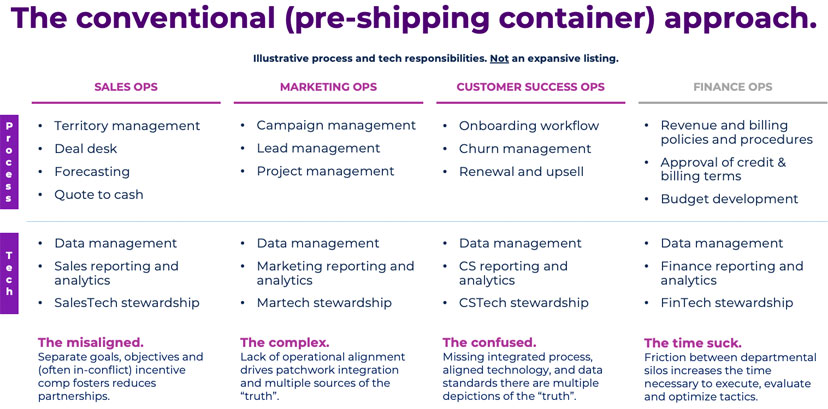
What’s up with the move to shift to revenue operations (RevOps)? Let’s start with some history.
In the 1950s, moving goods from point A to point B was a manual process, loading ships by hand. Dozens of men using ropes and pulleys to load irregularly shaped packages, boxes, crates, and bales into a ship’s hold. This was inefficient and time-intensive. A truck could wait an entire day just to get unloaded, and it might be a full month before that cargo was loaded onto a ship. Then when the ship arrived at its destination, everything happened in reverse. This entire process was expensive, but not due to long-distance transportation costs. Rather, the biggest cost was time and effort.
Ships, trains, and trucks worked together to transport goods around the world, but there was no standardization between them or the companies in each of these industries. Then one day, a shipping company created a standardized shipping container that could be lifted off the backs of trucks and placed straight into the hold of a cargo ship. This innovation didn’t come with fanfare—unions were violently opposed, and other companies were hesitant to change.
However, the idea panned out, reduced time and effort, and dramatically cut costs. Shipping containers are now the standard for shipping, and as a result, the transportation of goods went from expensive to cheap, and from manual and inconsistent to highly standardized. What does this have to do with Revenue Operations? Everything.
Much like how goods were transported in the 1950s, operations teams at most B2B organizations are siloed. There are teams for sales ops, marketing ops, and customer success ops.
- Process. Each of these operations teams support their respective departments by defining and stewarding the key processes and procedures necessary to support their function. As an example, sales ops drive territory management, the deal desk, forecasting, and quote to cash processes for the sales team.
- Technology. The operations teams also manage all of the technology, which includes the platforms that their departments use, but also the data their platforms contain and the analytics and reporting their teams use to evaluate individuals, the team, functions, and company performance.

Here’s the issue with the conventional operations approach.
Each operations team brings with it their own priorities, goals, and objectives, which many times are not aligned with the other operations teams. And when they do coincide, these differences in objectives drive different perspectives and steer the operations teams to taking different approaches.
- Misalignment. Technology and process planning tend to be siloed, focused on the core requirements of the department, but not end-to-end. And with that in mind, no one person or group actually owns the tech stack—operations teams only own the tech stack for their function. That leads to a Frankenstein-like state, where operation teams focus on optimizing for the individual departments often at the expense or the sub-optimization of others.
- Complexity. Simple questions, such as how many customers do we have, or what our churn was last quarter are difficult to answer because depending on the department, and the system used to pull the report, those answers vary. This happens when there are no agreed-upon data standards, and no agreed-upon KPIs or metrics, let alone an agreed specification on the filters to use for each report.
- Confusion. Much like the longshoremen of the 1950s, there is a lack of understanding and shared knowledge because operation teams are not aligned or unified.
- Responsiveness. As a result of the misaligned, complex, and often confused state of affairs, the time necessary to drive projects involving multiple departments is increased, and manual work abounds.
All this friction, all this tension is what’s spurring the growth and development of revenue operations—RevOps for short.
What is revenue operations (RevOps)?
RevOps is a concept, which speaks to the operational alignment of sales, marketing, and customer success. When that operational alignment is at its furthest point, RevOps becomes a centralized function, which subsumes marketing, sales, and customer support operations into one department.
- RevOps is a concept. RevOps is the alignment of sales, marketing, and customer success operations [on the operational level].
- RevOps is a department. RevOps is a function that provides operational support to the departments of marketing, sales, and customer success.
Primary drivers pushing us to revenue operations.
What’s intriguing about revenue operations, to me at least, is how we got there.

In B2B marketing, sales, and customer success, there is increased technical complexity and sophistication.
- Technology profusion. There was no such thing 20 years ago—heck, marketing ops at that time was an emerging trend. If we counted all of the marketing, sales, and customer success technologies, there would be 300 or less at best. That’s changed. Today, there is no marketing, sales, or customer success process not fully reliant on or at minimum aided by technology. Technology is everywhere in marketing, sales, and customer success, and the effective management and leadership of technology give companies an edge or a competitive weakness.
- Dr. Jekyll and Mr. Hyde. But there’s a lack of focus because operations teams roll up to department heads that need to split their attention between operations and their core departmental responsibilities. Not to mention, department heads frequently lack expertise in all of these operations. For example, most VPs of marketing don’t hold subject matter understanding of data normalization, or the difference between an API and web services. This creates a lack of focus on operational strategy and a lack of focus on the use of technology and operations as a strategy.
How we engage with prospects and customers has changed too.
- Subscription and SaaS. The shift to subscription and SaaS business models make it so what happens after a sale is equally important as the initial sale itself. This spurred a focus on increasing renewal rates and reducing churn, as well as the realization that touch-points from marketing, sales, and customer success needed to be choreographed.
- ABM. Then came ABM. ABM requires a unified operational back end to scale and deliver its full value. And for organizations that move forward with ABM when their marketing, sales and customer applications and processes aren’t aligned, friction emerges between the GTM teams and operations.
Read more about the move to revops, including why and how to make the move, in the rest of this series: Revenue Operations (RevOps) Benefits, Challenges in Establishing RevOps, How to Get Started with Centralized RevOps, and The Impact of Centralization on Revenue Operations.



